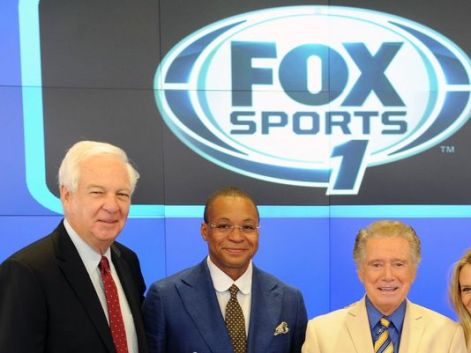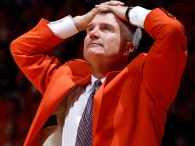
It has been a couple of days since the news broke from Sports Business Daily that Fox is poised to enter into a deal with the Big Ten for 50% of the packages that are currently on ABC/ESPN (football and basketball) and CBS (basketball)… for up to $250 million per year for 6 years. Once again, this is just for half of the Big Ten rights that are up for grabs, which would provide for 25 football games and 50 basketball games on over-the-air broadcast Fox (“Big Fox”) and FS1. As observers such as Matt Sarzyniak have noted (who has a great post on the overall dynamics of the Big Ten deal), that amount is approximately the amount that the Pac-12 receives for its entire non-Pac-12 network package. In effect, we’re about to enter into a world where Rutgers and Northwestern are going to earn significantly more TV money than Florida State, Oklahoma, USC and even Alabama and Notre Dame. The Big Ten schools were already ahead before through its creation of the BTN (which everyone should remember how bold and risky that move was a decade ago compared to taking guaranteed money from ESPN), but the gap is going to be blown through the roof if the conference ends up with around $500 million per year for its TV rights without even taking into account the BTN portion. I have had plenty of critiques of Jim Delany and the Big Ten leadership over the years, but their management of TV and media properties has been pitch perfect for the past ten years and far beyond the capabilities (both quantitative and qualitative) of the other power conferences.
Some further thoughts:
- I have seen a lot of scuttlebutt online that this indicates that the Big Ten might be leaving ESPN entirely, but personally don’t believe that for a second. For several years, I’ve been predicting that Fox and ESPN will ultimately split the Big Ten’s rights going forward and that is still the most likely outcome. ESPN reportedly “lowballed” the Big Ten in its initial offer, yet that is not necessarily outcome determinative since ESPN did the same thing ten years ago (which eventually spurred the creation of the Big Ten Network) and the parties still eventually got a deal done. It would have been difficult for ESPN to unilaterally come in with a massive offer several weeks ago with the continued cost-cutting throughout its organization and the possibility that this might be the time when the sports rights bubble (to the extent that there actually is a bubble) is going to pop. Essentially, ESPN bet that there wouldn’t be anyone willing to pay the Big Ten’s high asking price (just as it bet that the BTN wouldn’t be successful)… and it looks like they’re going to lose that bet badly.That being said, I’ve written many times before that ESPN’s supposed financial woes are being completely misinterpreted by many sports fans. The reason why so many Disney investors are spooked by any cord cutting and ESPN subscriber losses is because ESPN is, by far, the most profitable media and entertainment entity in the entire world. Note that I said “media and entertainment entity” – this is not just about sports networks. Let’s put it this way: ESPN currently delivers monthly subscriber revenue to Disney that is the equivalent to the domestic gross of Star Wars: The Force Awakens every single month guaranteed… and before they sell a single ad. Disney has relied upon ESPN to deliver monopoly drug dealer profits for years to prop up their entire business. Now, ESPN is “only” making oligopoly drug dealer profits.
All of this is to say that ESPN still makes a ton of money that is far, far, far beyond what Fox, NBC, CBS, Turner or any other entity with sports interests could ever dream of. Even in cost-cutting mode, ESPN still needs to invest in core properties in the same way that the rest of the cost-cutting Disney organization will authorize massive budgets for Star Wars, Marvel, Pixar and Disney Princess movies. ESPN leadership can now go back to their overlords at Disney and say, “Look – we tried to get the Big Ten on the cheap and that clearly isn’t going to happen. We have now already let Fox into the door to becoming a top tier sports network competitor and we can’t let someone else, especially NBC/Comcast, to get even more traction on top of them. We need to the funds to pay up here.” Anyone that thinks that ESPN can just plug in more SEC or ACC games into its lineup is fooling themselves. The Big Ten provides a massive lineup of football games in the best time slots on ABC and ESPN and have consistently garnered the best ratings of any of the conferences next to the SEC. The people at ESPN aren’t dumb – they know the difference between a short-term administrative cost cut and a long-term investment in their core product… and the Big Ten has been a huge part of their core product since almost the beginning of the network.
- By the same token, let’s not pretend that the Big Ten wants to get away from ESPN. I have seen some Big Ten fans profess a desire to leave ESPN entirely, but that would be as short-sighted for the conference as it would be short-sighted for ESPN to let the Big Ten go completely. The fact of the matter is that if you were to show the exact same game on ESPN versus FS1, the viewership on ESPN would be magnitudes higher. We have already seen a track record of Major League Baseball, Big 12 and Pac-12 games where similar games on ESPN crush the ratings on FS1. There has to be great concern that the notion that “fans will just find the channel if they want to watch a particular game” isn’t necessarily completely true. ESPN is, and will be for the foreseeable future because the stranglehold that they have on sports rights overall, the “default channel” for sports fans. Just walk into any sports bar across the country and, outside of NFL Sundays, the vast majority of TVs are going to be tuned into the ESPN mothership. A game that is shown on ESPN literally gets a ratings bump, whereas that same game on FS1 gets a ratings discount.This greatly matters to the Big Ten, which is trying to position its TV deals in the same way that the NFL has over the past few years. Money certainly matters, but long-term money (the proverbial golden goose) is directly correlated with exposure… and no one can provide exposure like ESPN. Indeed, even with the increase in cord cutting and falling numbers of subscribers, every single other media company in the United States would kill to have ESPN. We have already established that they have the top-rated and most profitable TV network, but it goes beyond just that aspect. Who has the #1 sports news website? ESPN. Who has the #1 sports radio network? ESPN. Who has the #1 sports mobile app? ESPN. Who has the #1 streaming sports network? ESPN. Who has the #1 sports podcast network? ESPN.
That is what a lot of Big Ten fans that care too much about supposed “SEC bias” on ESPN are missing: there is simply no replication for the multi-platform 27/7 exposure that ESPN provides.* Many other companies have tried to apply the ESPN playbook for years and years (see the CBS and Fox efforts to build their own sports websites and radio networks with only a fraction of the audience of ESPN) and have failed. When a Big Ten game is on ESPN, it gets promoted on (a) Mike and Mike on TV, radio, streaming audio and podcasts simultaneously, (b) SportsCenter on multiple networks several times per day, (c) ads on ESPN’s websites and mobile apps, (d) countless other TV, radio shows and podcasts for an entire week, including the all-important College GameDay for college football fans. Other than Inside the NBA on TNT (which is powered by the on-air brilliance of Charles Barkley, there is not a single cable TV platform in any sport that has anywhere close to the audience that ESPN has for even one of its minor shows, much less SportsCenter, GameDay or Mike and Mike.
(* Note that it isn’t an accident that ESPN is a master of corporate synergy considering that it is owned by Disney, whose entire existence is based on leveraging its brand across countless platforms. I have never heard of someone that likes Universal Studios, the Jurassic Park movies and NBC call themselves a “Comcast Fan” or a fan of Fox shows and movies call themselves a “Fox Fan” (which is distinct from a Fox News Fan that is an entirely different breed), but you will find millions of Disney fans that travel to Disney parks, watch Disney movies and TV shows and buy Disney merchandise with the Disney branding being a the predominant factor. My sister is a prime example of a Disneyphile. Disney and ESPN simply are masters at synergy via corporate culture that can’t really be replicated even if you followed the exact same playbook elsewhere… and believe me when I say that every one of their competitors have tried.)
At the end of the day, the Big Ten still needs the exposure that only ESPN can uniquely offer. It’s instructive that out of the 4 major pro sports leagues and 5 power college conferences, the only one that doesn’t have a presence on ESPN is the NHL (which has by far the most limited fan base of that group). Just because the Big Ten could theoretically live without ESPN doesn’t mean that it actually wants to do so at all. That’s why I believe that time will heal wounds due to mutual interests and a deal will get done between the Big Ten and ESPN for the other half of the TV rights that are currently in play. The Big Ten won’t take a lowball amount from ESPN, but I think they know well enough to provide a bit more leeway for ESPN’s bid in acknowledgment of their superior platforms for overall exposure compared to Fox. Both the Big Ten and ESPN need each other here.
- In looking at the imminent Fox deal with the Big Ten, this seems to be set up to put a weekly football game on both Big Fox and FS1. This will end up being quite a boon for Fox’s college football game inventory quality. From a personal standpoint, I just hope that it improves that actual college football game production quality, which I have found lacking compared to ABC/ESPN and CBS. (I think that NBC’s Notre Dame productions have quality visuals, but the commentary is the college football equivalent of listening to Hawk Harrelson’s calls of White Sox games.) Regardless, if this means that most or all of the games that would have ended up on ESPN2, ESPNU or ESPNEWS are on Big Fox and FS1, then that’s an upgrade in terms of viewership exposure as long as the Big Ten keeps its presence on ABC and the ESPN mothership.Further to what I’ve stated before, I don’t think Fox is as flush with funds as much as ESPN (because absolutely no one is as flush with funds as ESPN), but Fox certainly has a lot more incentive to make a bold move with it being in the upstart position. In particular, FS1 has had a rocky history in its short life. On paper, FS1 has the best sports rights outside of ESPN on paper with MLB, Big 12, Pac-12, Big East, NASCAR, Champions League, FIFA (World Cup), UFC and USGA (U.S. Open) properties, but it doesn’t seem to have a cohesive brand even compared to NBCSN (which seems to have become the yuppie/hipster sports network largely relying upon the NHL, English Premier League and Olympics), much less ESPN. At the very least, the Big Ten may push Fox over-the-top in terms of being a legit college sports destination that it hasn’t quite been up to this point.
Realistically, Fox can never achieve the synergy that ESPN can provide, but there are strong potential cross-promotional opportunities between Fox’s over-the-air NFL package and the new Big Ten coverage along with the clear connection between BTN (which is 51% owned by Fox) and the rest of the Fox organization. The NFL broadcasts on Fox are by far the strongest on the network (which ought to be the case since they are also by far the largest ratings drivers for Fox), so let’s hope that the Big Ten can receive at least comparable quality in terms of treatment.
- The reported 6-year timeframe of the Fox deal is unusual compared to the much longer-term deals that the other power conferences have signed. In fact, the Big Ten will end up back at the negotiating table before any of the other power conferences once again. On the one hand, this presents some risk to the Big Ten since they are not locking in today’s high rights fees into the late-2020s or even 2030s. On the other hand, every time that the Big Ten has bet on itself, it has ended up succeeding, whether it was with the formation of the BTN or taking its rights to the open market in a period of uncertainty for sports programming values with decreasing cable subscriptions. By the same token, Fox may be hedging on cable subscriber fee uncertainty itself, as Dennis Dodd had suggested.In any event, the short length of the TV deal means that conference realignment talk might cool down in the immediate term, but will pick up a huge amount of steam in the next 5 years. Whether it’s a coincidence or not (and I tend to think “not”), the end of the 6-year deal term in 2023 is shortly before the expiration of the Big 12’s grant of rights agreement in 2025, which makes any possible damages for a Big 12 defector to be much lower and/or negligible compared to a Big Ten windfall. The same usual suspects of Texas, Oklahoma and Kansas as Big Ten candidates. It will also be interesting to see how schools in other conferences (particularly the ACC) are going to adjust to an environment where each Big Ten school could be receiving nearly $60 million per year in media revenue starting in 2017 (as estimated by Awful Announcing), which would lap the SEC’s revenue (much less any of the other power conferences). A few million dollars per year difference in TV revenue may not have been enough to sway the most valuable schools (e.g. Texas, North Carolina, etc.) to switch conferences, but when we’re looking at an eight figure annual gap, it could change the dynamic quite a bit.
The announcement by Jim Delany at the end of 2009 that the Big Ten was exploring expansion was leading to this moment of a new TV contract. Nebraska added a national name brand for football, while Rutgers and Maryland added two massive media markets based on the East Coast. This isn’t the end, though. I still believe that ESPN is going to end up with the other half of the rights. It will be interesting to see what happens with the CBS basketball package (which hasn’t been talked about as much) since that provided great exposure and time slots for the Big Ten (such as the Big Ten Tournament Championship Game leading into the NCAA Tournament Selection Show) even if the contract value itself pales in comparison with football. Digital rights are going to be a much more significant factor in this new contract compared to 10 years ago, while some second tier sports such as hockey, baseball and lacrosse could end up seeing more telecasts beyond the BTN with multiple other networks. The Big Ten’s new Fox deal is a great start and it’s a sign of great things once we get the final overall media rights picture for the conference.
(Image from Detroit Free Press)







